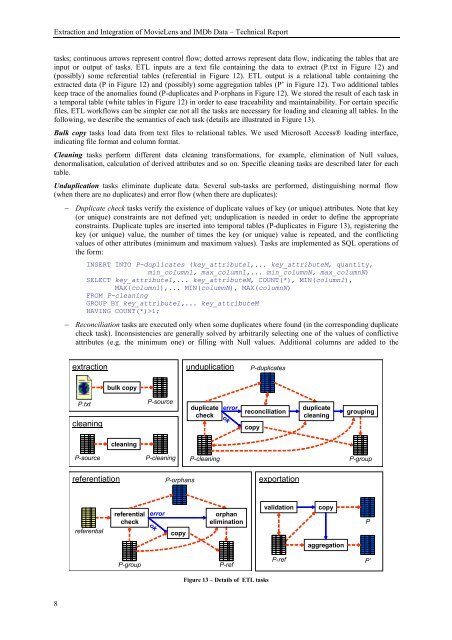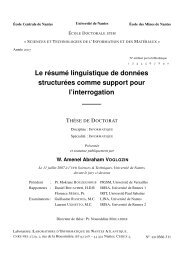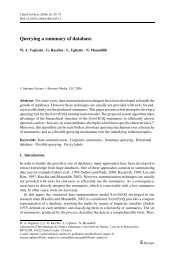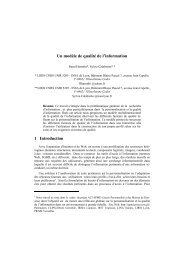Extraction and Integration of MovieLens and IMDb Data - APMD
Extraction and Integration of MovieLens and IMDb Data - APMD
Extraction and Integration of MovieLens and IMDb Data - APMD
Create successful ePaper yourself
Turn your PDF publications into a flip-book with our unique Google optimized e-Paper software.
<strong>Extraction</strong> <strong>and</strong> <strong>Integration</strong> <strong>of</strong> <strong>MovieLens</strong> <strong>and</strong> <strong>IMDb</strong> <strong>Data</strong> – Technical Report<br />
tasks; continuous arrows represent control flow; dotted arrows represent data flow, indicating the tables that are<br />
input or output <strong>of</strong> tasks. ETL inputs are a text file containing the data to extract (P.txt in Figure 12) <strong>and</strong><br />
(possibly) some referential tables (referential in Figure 12). ETL output is a relational table containing the<br />
extracted data (P in Figure 12) <strong>and</strong> (possibly) some aggregation tables (P’ in Figure 12). Two additional tables<br />
keep trace <strong>of</strong> the anomalies found (P-duplicates <strong>and</strong> P-orphans in Figure 12). We stored the result <strong>of</strong> each task in<br />
a temporal table (white tables in Figure 12) in order to ease traceability <strong>and</strong> maintainability. For certain specific<br />
files, ETL workflows can be simpler car not all the tasks are necessary for loading <strong>and</strong> cleaning all tables. In the<br />
following, we describe the semantics <strong>of</strong> each task (details are illustrated in Figure 13).<br />
Bulk copy tasks load data from text files to relational tables. We used Micros<strong>of</strong>t Access® loading interface,<br />
indicating file format <strong>and</strong> column format.<br />
Cleaning tasks perform different data cleaning transformations, for example, elimination <strong>of</strong> Null values,<br />
denormalisation, calculation <strong>of</strong> derived attributes <strong>and</strong> so on. Specific cleaning tasks are described later for each<br />
table.<br />
Unduplication tasks eliminate duplicate data. Several sub-tasks are performed, distinguishing normal flow<br />
(when there are no duplicates) <strong>and</strong> error flow (when there are duplicates):<br />
8<br />
− Duplicate check tasks verify the existence <strong>of</strong> duplicate values <strong>of</strong> key (or unique) attributes. Note that key<br />
(or unique) constraints are not defined yet; unduplication is needed in order to define the appropriate<br />
constraints. Duplicate tuples are inserted into temporal tables (P-duplicates in Figure 13), registering the<br />
key (or unique) value, the number <strong>of</strong> times the key (or unique) value is repeated, <strong>and</strong> the conflicting<br />
values <strong>of</strong> other attributes (minimum <strong>and</strong> maximum values). Tasks are implemented as SQL operations <strong>of</strong><br />
the form:<br />
INSERT INTO P-duplicates (key_attribute1,... key_attributeM, quantity,<br />
min_column1, max_column1,... min_columnN, max_columnN)<br />
SELECT key_attribute1,... key_attributeM, COUNT(*), MIN(column1),<br />
MAX(column1),... MIN(columnN), MAX(columnN)<br />
FROM P-cleaning<br />
GROUP BY key_attribute1,... key_attributeM<br />
HAVING COUNT(*)>1;<br />
− Reconciliation tasks are executed only when some duplicates where found (in the corresponding duplicate<br />
check task). Inconsistencies are generally solved by arbitrarily selecting one <strong>of</strong> the values <strong>of</strong> conflictive<br />
attributes (e.g. the minimum one) or filling with Null values. Additional columns are added to the<br />
extraction<br />
P.txt<br />
cleaning<br />
referentiation<br />
referential<br />
bulk copy<br />
cleaning<br />
referential<br />
check<br />
P-group<br />
P-source<br />
P-source P-cleaning<br />
error<br />
ok<br />
P-orphans<br />
copy<br />
unduplication<br />
duplicate<br />
check<br />
P-cleaning<br />
error<br />
ok<br />
orphan<br />
elimination<br />
P-ref<br />
P-duplicates<br />
reconciliation<br />
copy<br />
Figure 13 – Details <strong>of</strong> ETL tasks<br />
exportation<br />
validation<br />
P-ref<br />
duplicate<br />
cleaning<br />
copy<br />
aggregation<br />
grouping<br />
P-group<br />
P<br />
P’







